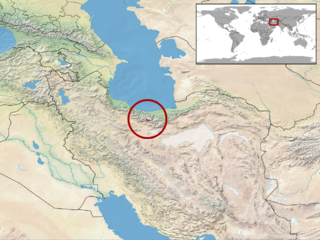
The International Union for Conservation of Nature (IUCN) Red List of Threatened Species, founded in 1964, is the world's most comprehensive inventory of the global conservation status of biological species. It uses a set of precise criteria to evaluate the extinction risk of thousands of species and subspecies. These criteria are relevant to all species and all regions of the world. With its strong scientific base, the IUCN Red List is recognized as the most authoritative guide to the status of biological diversity. A series of Regional Red Lists are produced by countries or organizations, which assess the risk of extinction to species within a political management unit.

The tamaraw or Mindoro dwarf buffalo is a small hoofed mammal belonging to the family Bovidae. It is endemic to the island of Mindoro in the Philippines, and is the only endemic Philippine bovine. It is believed, however, to have once also thrived on the larger island of Luzon. The tamaraw was originally found all over Mindoro, from sea level up to the mountains, but because of human habitation, hunting, and logging, it is now restricted to only a few remote grassy plains and is now a critically endangered species.

Montivipera latifii is a species of venomous snake in the subfamily Viperinae of the family Viperidae. The species is endemic to Iran. There are no subspecies that are recognized as being valid.

Rhodeus suigensis is a temperate freshwater fish belonging to the Acheilognathinae subfamily of the family Cyprinidae. It originated in inland rivers in Japan and the Korean peninsula. It was originally described as Pseudoperilampus suigensis by T. Mori in 1935, and has also been referred to as Rhodeus atremius suigensis in scientific literature. The species was listed as endangered in 1994 by the World Conservation Monitoring Centre, but in 1996 was relisted as "data deficient". When spawning, the females deposit their eggs inside bivalves, where they hatch and the young remain until they can swim.

A species that is extinct in the wild (EW) is one that has been categorized by the International Union for Conservation of Nature as known only by living members kept in captivity or as a naturalized population outside its historic range due to massive habitat loss.

Bullockia maldonadoi is a species of catfish of the family Trichomycteridae, and the only species of the genus Bullockia. This fish grows to about 7 centimetres (2.8 in) and originates from Chile.

Archidendron bigeminum is a tree species in the legume family (Fabaceae). It is found in India and Sri Lanka. It is known as "Kalitiya - කලටිය" in Sinhala people.
Kikuzato's brook snake, also known commonly as Kikuzato's stream snake, is a species of snake in the family Colubridae. The species is endemic to Japan.

The Somali hedgehog is a species of mammal in the family Erinaceidae. It is endemic to Somalia and Somaliland. The Somali hedgehog is nocturnal.
The phleophagan chestnut moth was a species of moth in the family Nepticulidae. It was endemic to the United States, where it was known from Virginia.
Aplochiton marinus is a species of fish in the family Galaxiidae. It is an amphidromous fish migrating between ocean and fresh water.
The Lake Pedder planarian is a species of invertebrate in the family Dugesiidae.
Brennania belkini is a species of fly in the horse-fly family, Tabanidae. It is native to the Los Angeles area in California, and it is also found in Mexico. It is known commonly as Belkin's dune tabanid fly.
Megadytes ducalis is a species of water beetle in the family Dytiscidae. With a length of 4.75 cm (1.9 in), it is the largest species in the family. Until recently, the species was only known from a single specimen that was collected in the 1800s from an unknown locality in Brazil, although rumors indicate it was found in the bottom of a canoe in the Amazon. In 2019, a study reported 10 additional specimens, all collected from the end of the 19th century, discovered incidentally in various historical collections. While the original holotype lacked any location data, the new specimens all indicate that they were collected in Santo Antonio da Barra in the southern part of Bahia, Brazil. Villagers in the region were involved in insect trade, capturing the much sought after specimens of Hypocephalus armatus found around the region. As a consequence of the lack of recent records, the IUCN lists it as extinct. Considering the absence of information about the species and the limited studies conducted on water beetles in Brazil, it might still survive.









